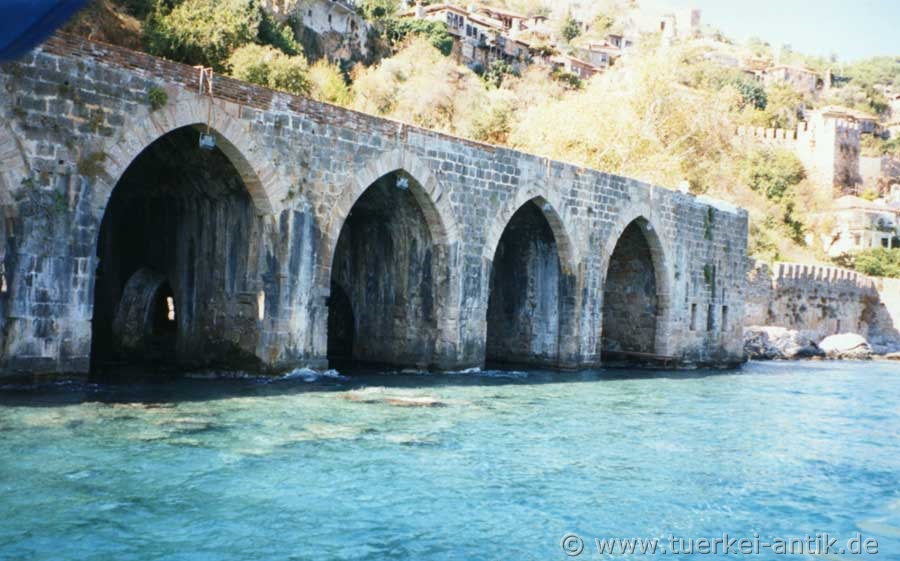 |
| Korakesion (today Alanya) | |||
|
|
|
||
| The fortress on the east side | |||
|
The traces of ancient Korakesion (Latin Coracesium) are today limited to the fortress mountain, which can be seen from afar and which probably began in the 3rd century B.C. and was later extended further and further. In Seljuk period the Red Tower (Kızıl Kule) and a shipyard were built. |
|||
|
|
|||
|
Alanya Fortress is situated on a rocky outcrop directly in the sea. Because of its location, it was difficult to reach from both land and water and was therefore easy to defend for centuries. Alanya Rock was for a long time the basis for the settlement of early civilizations. They can be traced back to the 4th century BC. In the early Hellenistic period, the uppermost tip of the rock outcrop was equipped with a defensive wall. In the following centuries it was further developed. The impressive fortress we can visit today was completed by the Seljuks. |
|||
|
|
|||
| The fortifications and the northern bastion, the Ehmedek | |||
|
The fortress consists of three main sectors, the outer, the middle and the inner sector. The outer sector stretches from the hill over the Red Tower to the Ehmedek and the Arap Evliyası and then back down to the sea. This sector contains important buildings from Seljuk times, such as the Red Tower, the Shipyard and the Tophane Tower. The middle sector is located between the walls of the Arap Evliyası tower and the citadel (İçkale). In the middle part are the Akşebe Türbesi, a bathhouse and the Ehmedek, the northern bastion all also from Seljuk times. The Sülemaniye Mosque and Bedesten date from the Ottoman period. |
|||
|
|
|||
| The landmark of Alanya, the Red Tower (Kızıl Kule) | |||
|
|
|||
|
The "Red Tower" was built in 1226 at the behest of the Seljuk Sultan Alaeddin Keykubad I.
|
|||
|
|
|||
| The top floors of the tower | |||
|
|
|||
|
|
|||
|
|
|||
|
From the tower, the defenders had access to the battlements of the fortification walls of the lower defense line. |
|||
|
|
|||
| Weir passage of the lower defence system | |||
|
|
|||
|
|
|||
|
The Seljuk Shipyard of 1227 |
|||
|
The shipyard was built in 1227 by the Seljuk sultan Alaeddin Keykubad I. like the Red Tower in front of it. It has 5 vaulted floating docks and was 57 metres wide and 40 metres deep. The shipyard was used for the construction and repair of smaller ships and was considered the second most important maritime base of the Seljuks after the port of Sinop on the Black Sea. With their establishment the Seljuks became a power on the Mediterranean and Alaeddin Keykubad received the honorary title "Sultan of both seas". |
|||
|
|
|||
|
In ancient times the city was known as Korakesion. Until the 2nd century B.C., despite many influences, it retained its independence. In the 2nd century B.C. the pirate Diodotos Tryphon took over the city, which became known as the pirate port. The part of the defensive wall that stretches from the shrine of Arap Evlİyası to Ehmedek is assigned to the time of Tryphon's rule. Recognizable by the construction, in which no mortar was used, and the size of the stone blocks.
The history of the city in the Byzantine period is largely unknown. One only knows that the city was called Kalanoros (beautiful mountain) in this time. Some buildings have survived the Byzantine period, such as the 11th century AD church in the citadel, Arap Evliyası, a small monastery near the Cilvarda site and the round towers in the middle sector, which stand in a row to the citadel of the fortress.
From the 11th century the city was ruled by Armenian princes. In 1221 A.D. the then ruler Kyr Fard handed the city over to the advancing Seljuk sultan Alaeddin Keykubad in exchange for the governor's post in Akşehir.
The top of the castle rock shows many examples of urban, military and religious architecture, such as mosques, churches, cisterns, market halls, barracks, baths, etc.
|
|||
| Photos: @chim | |||
| Translation aid: www.DeepL.com/Translator | |||
| Source: Wikipedia and others | |||
|
|
|||


